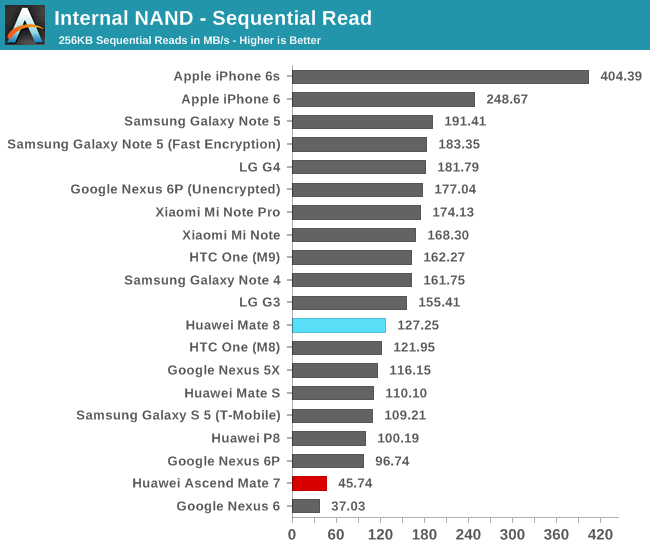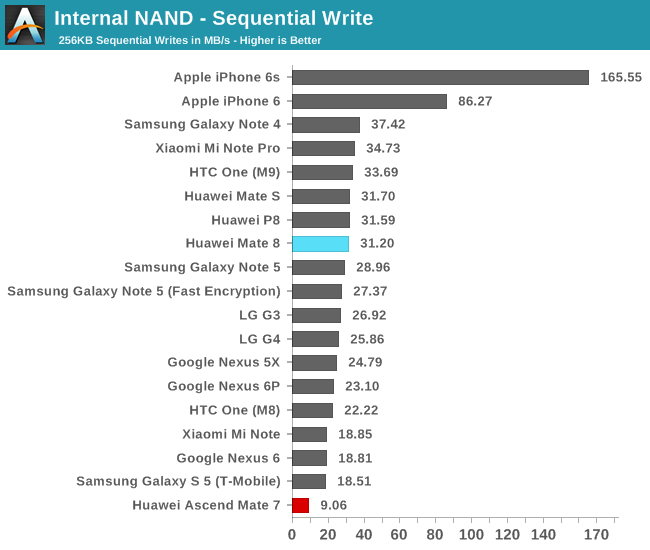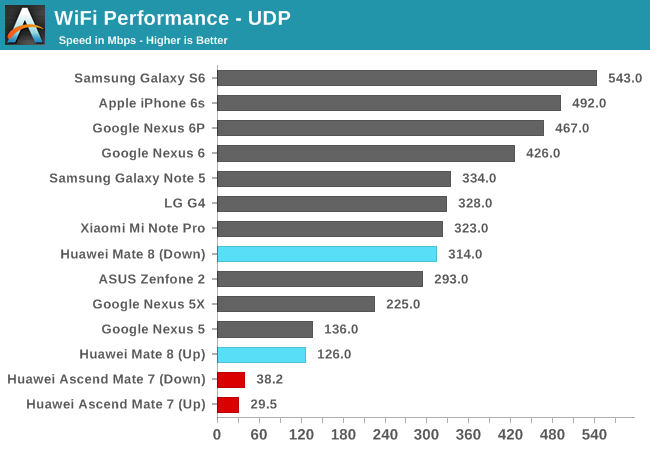The Huawei Mate 8 Review
by Andrei Frumusanu on January 5, 2016 1:00 PM EST- Posted in
- Mobile
- Smartphones
- Huawei
- Cortex A72
- Kirin 950
- Mate 8
- CES 2016
Camera Video Performance
Video recording quality was one of the weaknesses of previous Huawei phones. The Shenzhen manufacturer only introduces OIS last year with the P8 and in devices before that we saw poor ISP performance as videos generally lacked detail. In terms of video encoding we see usage the Kirin 950’s encoder block IPs by Imagination Technologies.
Note: We have yet to confirm if video recording is affected by the camera focus issue and thus can’t differentiate between lack of detail caused by either the optical system or the ISP’s processing.
1080p30 - Optical Image Stabilization
At 1080p the Mate 8 is able to offer better detail than past devices such as the Mate S. We actually see the video bitrate more than doubled as by default 1080p30 is now recorded at 23.7Mbps instead of the 10Mbps of past Huawei devices. This really helps overall image clarity.
The Mate 8’s new 3-axis OIS does a better job at keeping a still image, however Huawei hasn’t managed to get rid of the abrupt module repositioning and we thus still see jagged motions. Unfortunately Huawei still has a lot of work to do to catch up to OIS systems of other manufacturers such as from LG or Samsung.
1080p30 - Optical + Electrical Image Stabilization
The camera application offers the option to enable EIS in the settings (“Stabilizer” option). I’m a bit disappointed here to see that the new ISP still struggles to maintain proper quality as it’s very visible that the resulting video is just a cropped and re-scaled frame out of a native 1080p stream from the camera sensor. This results in large loss of detail and my repeated recommendation to just not use this feature.
1080p60 - Optical image stabilization
I was surprised to find 1080p60 among one of the recording modes as HiSilicon had briefed me telling that the encode capabilities of the Kirin 950 hadn’t evolved, but seemingly this is wrong as 60fps recording is very well present and working. I was surprised by the video’s bitrate as Huawei set a rather high 47MBps encode configuration for the mode. This results in a noticeable improvement in detail which is welcomed. It also seems that OIS is functioning at a higher sampling rate as we see much less jagged “travel” as it looks as if we’re dealing with increased finer movements of the module.
Selecting 1080p30 disables the option to use a “Beauty” mode which is popular with some users, and again 1080p60 disables the option to use EIS. This points out that HiSilicon’s video ISP architecture is DSP based and has limited resources available to it as it needs to disable features as video throughput increases. This might also have been one of the reasons why the vendor chose not to employ 4K media encoders as it might have still been bottlenecked by the ISP.
Sound recording continues to be very clear for the Mate 8 although for some reason the default volume was much too low making it very hard to listen to recorded videos both on desktop as well as the phone itself. One can hear that in the first ~1s of the video the audio is louder after which it seems some sort of too high dynamic range compression is applied. This actually represents a large usability issue that I hope gets resolved in future software updates.
NAND Performance
My unit of the Mate 8 came with a SanDisk SDW32G eMMC chipset. This is an eMMC 5.0 part running in HS400 data rate mode, meaning at frequency of 200MHz DDR at with a bus width of 8 bit enabling a maximum throughput of 400MB/s. The controller used is one of the 3 Synopsis DesignWare blocks on the Kirin 950, with the second controller being used for the SD card with help of an Arasan PHY IP, and the third one connecting the WiFi combo chipset.
We’ve noticed that Android 6.0 has broken our usual test setup of AndroBench 3.6 as the random I/O tests aren’t able to properly report their scores. As such while we’re looking for better alternatives (Other than AndroBench 4.0) I’m keeping it simple and just reporting the sequential read and write speeds for 3.6.

The Mate 8 managed 127MB/s sequential read which puts it at the lower end of last generation flagships. Unless I’m mistaken the phone comes unencrypted and Huawei also doesn’t offer the option to encrypt the phone as it’s missing from the settings menus. HiSilicon has confirmed to me that the Mate 8 has FDE enabled by default and that the performance listed represents the encrypted performance of the phone.

Write speeds come in at 31.2 MB/s which is relatively good in comparison to other devices. Here we see the huge improvement over last year’s Mate 7 as it notoriously suffered from horrible NAND speeds as it used a eMMC dated back to 2012.
For the sake of completion, the AndroBench 4.0 numbers for the device was able to attain 127.55 and 48.68MB/s sequential read and writes and 17.32 and 6.27MB/s random read and writes.
WiFi Performance
WiFi connectivity and performance was sort of an absolute disaster for Huawei over the last year as every device we’ve reviewed sported horrible WiFi speeds or outright did not even support the 5GHz band.
The Mate 8 finally improves the situation as we see the old Broadcom BCM4334 dropped in favour of a new BCM43455. We actually covered this piece last MWC as it was introduced by Broadcom. Being a 1x1 HT80 solution capable of 802.11ac on both 2.4 and 5GHz bands we should see speeds of up to 433Mbps. As mentioned earlier in the NAND section, the WiFi chipset is connected via SDIO so it’s likely that the Mate 8 isn’t as power efficient as PCIe implementations and may be one of the factors of why maximum battery life isn’t quite as high as I expected it to be.

On the downstream direction we’re indeed seeing speeds somewhat in line with the theoretical maximum as the Mate 8 reaches 314Mbps. What continues to baffle me though is that we’re again seeing a large discrepancy between downstream and upstream as I was only able to reach 126Mbps upload on the device. It seems Huawei again is using some kind of limiter or traffic shaper on this device. Again I’m not too sure why they’re doing this and if it has anything to do with power efficiency but it’s definitely an odd characteristic exclusive to Huawei.
On 2.4GHz the Mate 8 reaches 78.6Mbps downstream and 67Mbps upstream, also displaying >2x improvements over past devices. While we don’t yet have objective testing for WiFi reception, I also noticed connectivity range on the Mate 8 greatly improved over the Mate 7.










116 Comments
View All Comments
Ethos Evoss - Wednesday, January 6, 2016 - link
Problem with ipones is that prices DOESN'T go down quickly.. For this Mate 8 it will soon be cheaper .. Mate 7 released in october or november 2014 and in december I bought it just for £300 on ebaySo it will be the same with mate 8 but forget iphone 6s to be cheap man..
s.yu - Saturday, January 16, 2016 - link
Haha they say the same about Huawei in China, except they meant it the other way around, "prices go down so slow so Huawei must be good~ look at that crappy Samsung that drops 1/3 of its price in a few months~"jasonelmore - Wednesday, January 13, 2016 - link
it is quite a bit cheaper, your $700 figure is for a 128GB model, and a 128GB 6S Plus is a Grand dude. Look at the lower storage models, they are still cheaper than a iphone by 25% (even beats your toyota/hyundai comparison)MaxIT - Monday, February 15, 2016 - link
I mostly agree about your pricing point, a Huawei can't be so pricey , but your cars analogy is very poor: Hyundai and especially Toyota / Lexus (Japanese cars !) are making very good cars, even better than American's...jjj - Tuesday, January 5, 2016 - link
Mentioned this before, the SoCs memory score in Geekbench is all over the place, you haven't noticed anything off there?Other than that the SoC does ok , a bit of a pity that they don't use better NAND and WIFI since it would make a rather big difference in actual usage. Power is not ideal since it does throttle and you could have pushed further and load all 8 cores. The product should work at advertised speeds , anything less should be clearly disclosed to the consumer but considering how bad things are elsewhere , this is great.
The phone is a bit pricey, the screen is just 1080p and not quite ok colors. Too bad since it's one of the most compact designs and almost nobody is doing that now, except maybe LeTV.
Any clue on die size? Hope we see the SoC in better offerings, assuming it's not too big (and costly).
lilmoe - Tuesday, January 5, 2016 - link
"the screen is just 1080p"shhhhh, just shhhhhhhh
jjj - Wednesday, January 6, 2016 - link
I wouldn't complain about that if it was 200$ but it's not. There is a reason 1080p screens are in 120$ phones (even rather good displays like the one in the Meizu m2 Note). And it is 6 inch so you get about 367ppi vs 577 ppi in something like the S7.lilmoe - Wednesday, January 6, 2016 - link
You also get amazing battery life.....You believe that they need to add a "premium" screen to justify the asking price, when the "cheaper" parts are in fact better for the experience. I'd rather have them spend the savings on other components, like better flash, audio amplifiers with a better DAC, and a general better internal layout of components for easier repairability.
If all parts are optimum and they still save a good buck on their BoM, then good for them.
s.yu - Saturday, January 16, 2016 - link
They're selling them to presbyopic middle-aged men on the verge of retirement who only need the phones to make calls, they can't see so clearly close-up in the first place so they need huge screens and not a lot of DPI. Don't count on a better DAC, it doesn't fit their positioning, especially in China, their main market.lucam - Tuesday, January 5, 2016 - link
..and what about the iPad Pro?